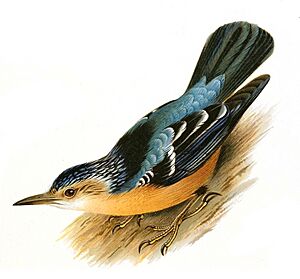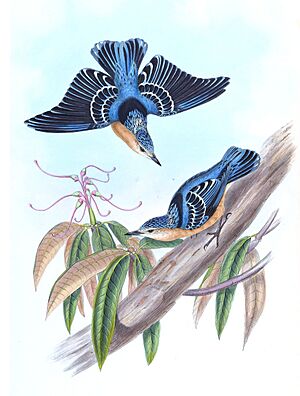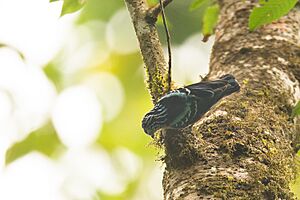Beautiful nuthatch facts for kids
Quick facts for kids Beautiful nuthatch |
|
|---|---|
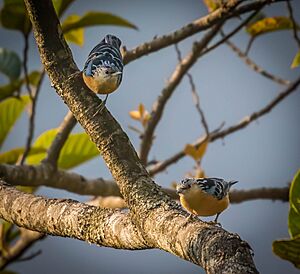 |
|
| A pair of beautiful nuthatches in Bhutan | |
| Conservation status | |
| Scientific classification | |
| Genus: |
Sitta
|
| Species: |
formosa
|
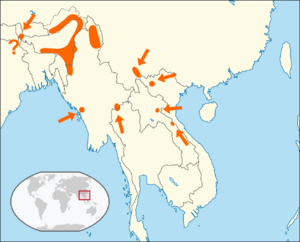 |
|
| Synonyms | |
|
• Callisitta formosa (Blyth, 1943) |
|
The beautiful nuthatch (Sitta formosa) is a special bird known for its amazing colors. It belongs to the nuthatch family. This bird is quite large for a nuthatch, about 16.5 cm (6.5 inches) long. Both male and female beautiful nuthatches look the same.
Their feathers are very striking. The top part of their body is black and bright blue, with white and light blue stripes on their head. Their wings also have colorful lines. The bottom part of their body is orange. They have a yellowish-brown patch above their eye and on their throat. A dark stripe goes across their eye.
Beautiful nuthatches eat small insects and their larvae (young insects). They find this food on tree trunks and branches covered in plants like moss. They usually lay four to six eggs in a nest built inside a tree hole, often in oak or rhododendron trees.
Even though these birds live in many countries in mainland Southeast Asia, they are quite rare. They prefer to live in montane forests, which are forests found in mountains, at heights from about 950 meters (3,100 feet) to nearly 2,300 meters (7,500 feet). In winter, they might move to lower areas. Because they are so rare and live in specific spots, it's hard to count exactly how many there are. Their homes are threatened by deforestation, which is when forests are cut down. For this reason, the beautiful nuthatch is listed as a vulnerable species by the International Union for Conservation of Nature.
Contents
What is a Nuthatch?
Nuthatches are small passerine birds. This means they are perching birds, like sparrows or robins. They have short, strong wings and short, square tails. Their bodies are compact, and they have long, pointed beaks. Their toes are strong with long claws.
One cool thing about nuthatches is how they climb trees. They can climb down tree trunks head-first! Most nuthatches have gray or bluish backs and a black stripe across their eyes. The name Sitta comes from an old Greek word for nuthatches. The English word "nuthatch" comes from "nut" and a word like "hack," because these birds hack at nuts they've stuck into cracks in trees.
The beautiful nuthatch was first described in 1843 by a British zoologist named Edward Blyth. He studied a bird he found in Darjeeling. Scientists are still learning how the beautiful nuthatch is related to other nuthatches. Its bright blue feathers make it look like the blue nuthatch or velvet-fronted nuthatch. However, the beautiful nuthatch lives mainly in the eastern Himalayas, and its unique look suggests it might be quite different from other blue nuthatches. There are no known subspecies of the beautiful nuthatch.
How to Identify a Beautiful Nuthatch
The beautiful nuthatch truly lives up to its name with its amazing feathers. Its upper body is black and bright blue, while its underparts are orange. The top of its head and upper back are black with pale blue and white stripes. Its shoulders and lower back are bright blue.
Its wing feathers are black with thin white edges, forming two narrow stripes on its wings. The main flight feathers are black with some light blue lines. The area above its eye and its throat are white and yellowish-brown. A dark, uneven stripe goes across its eye.
When the bird flies, you can see the white base of its wing feathers. This stands out against the gray feathers under its tail. Its eyes are reddish-brown or dark brown. Its beak is black, but the bottom part is a bit whitish near its face. Its legs and feet are yellowish-brown or greenish-brown.
Male and female beautiful nuthatches look exactly alike. Young birds look similar to adults, but the stripes on their back are blue instead of white. Their underparts are also a bit paler, especially on the chest. Adult birds replace all their feathers after the breeding season. Young birds only replace some of their feathers.
This bird is large compared to other nuthatches. It measures about 16.5 cm (6.5 inches) long. Its folded wing is about 98 to 109 mm (3.8 to 4.3 inches) long in males and 97 to 100 mm (3.8 to 3.9 inches) in females. The tail is 48 to 60 mm (1.9 to 2.4 inches) long in males and 52 to 56 mm (2.0 to 2.2 inches) in females. Its beak is between 20 mm (0.8 inches) and 24.9 mm (1 inch) long. The lower leg bone (tarsus) is 19 to 22 mm (0.7 to 0.9 inches) long. We don't know its exact weight.
Life and Habits
Sounds and Calls
We don't know much about the beautiful nuthatch's sounds. Its song is described as "low and sweet." Its calls are like those of other nuthatches, similar to the Eurasian nuthatch, but not as loud.
What They Eat
Beautiful nuthatches usually look for food alone, in pairs, or in small groups of four or five. Sometimes, larger groups have been seen, like 21 birds in one tree in Bhutan! They often join mixed groups of birds looking for food together. They have been seen feeding with the Himalayan cutia and the velvet-fronted nuthatch, which also search for food on tree trunks.
S. formosa searches for food from the middle to the very top of tall trees. They explore tree trunks and branches covered in plants like lichens, mosses, and orchids. They look for small insects. They have also been seen feeding on the outer branches. In Laos, they were seen on large branches of Fokienia evergreen trees, which often have many plants growing on them.
These birds have been described as being very calm and unhurried while they peck at trunks, lichen, and other plants, searching for prey. The stomachs of some birds studied in China contained beetles and insect larvae.
How They Breed
Not much research has been done on how beautiful nuthatches reproduce. In northeast India, their breeding season is from April to May. They build their nests off the ground, usually between two and eight meters (6.5 to 26 feet) high. Nests are often found in holes in living or dead oak or rhododendron trees, or other large trees.
They build their nests using leaves and bark, held together with hair, often from bamboo rats. If the hole opening is too big, they use mud to make it smaller. The female usually lays four to six white eggs with red spots. Each egg is about 20.8 x 15.3 mm (0.8 x 0.6 inches). Both male and female beautiful nuthatches help build the nest and sit on the eggs to keep them warm.
Where They Live
This bird lives in the eastern Himalayas. It has been seen in different places across Southeast Asia, including northwest Vietnam and central Laos. Its range stretches west into northeast India, where it was once seen near Darjeeling. It lives in Bhutan and in several Indian states like Sikkim, Meghalaya, Assam, Arunachal Pradesh, Manipur, and Nagaland.
It's not certain if they live in Bangladesh, but they are found further east in northern Burma, in places like Chin State and Kachin State. We don't have much information about them in Laos, but there are reports of many birds spending winter in the wild area of Nakai–Nam Theun. They have also been seen in southeast China's Yunnan province, northern Thailand, and northwestern Vietnam. Their total living and breeding area is estimated to be about 376,000 square kilometers (145,000 square miles).
Beautiful nuthatches usually live inside and on the edges of evergreen or semi-evergreen montane forests. These are forests in mountainous regions. In northern Burma, they have even been seen nesting in trees in open areas. In central Laos, they were found living near Fokienia evergreen trees.
They usually live at heights of 950 meters (3,100 feet) up to nearly 2,300 meters (7,500 feet) during warmer times. However, they might move to lower areas in winter. For example, in India, they spend summer between 1,500 meters (4,900 feet) and 2,100 meters (6,900 feet). But in winter, they have been seen as low as 335 meters (1,100 feet) in Sikkim.
Dangers and Protection
The beautiful nuthatch has always been rare and found only in specific places. This might be because it needs very particular types of environments. Even though the bird is less threatened at high altitudes, its home is being lost due to deforestation. This happens because of logging and clearing forests for people to live. In central Laos and northern Vietnam, Fokienia trees, which the beautiful nuthatch uses for food and nesting, are cut down because they are very valuable.
Research from 2001 suggested there were between 2,500 and 10,000 adult beautiful nuthatches, and a total of 3,500 to 15,000 individuals. These numbers are going down. Because of these threats, the International Union for Conservation of Nature (IUCN) has classified the beautiful nuthatch as a vulnerable species. This means it faces a high risk of becoming extinct in the wild.
Images for kids



